Estimation of Field-Level NOx Emissions from Crop Residue Burning Using Remote Sensing Data: A Case Study in Hubei, China
Abstract
:1. Introduction
2. Study Area and Materials
2.1. Study Area
2.2. The MODIS Instrument and Fire Product
2.3. Crop Distribution Map
2.4. Environmental Monitoring Stations
2.5. OMI NO2 Product
2.6. Himawari-8 Fire Radiative Power Product
3. Methodology
3.1. Estimation of Fire Radiative Energy
3.2. Crop-Specific Emission Factors
3.3. Estimation of Field-Level NOx Emissions
4. Results and Discussions
4.1. Fire Distribution for Different Landcovers
4.2. Daily Maximum Fire Radiative Power
4.3. NOx Emissions for Different Landcovers
4.4. Comparisons
4.4.1. Validation with Himawari-8 FRP Data
4.4.2. Comparison with Previous Studies and Existing Database
4.4.3. Comparison with Space-Based Observations
4.4.4. Comparison with In Situ Observations
5. Conclusions
Author Contributions
Funding
Institutional Review Board Statement
Informed Consent Statement
Data Availability Statement
Conflicts of Interest
References
- Gao, C.; Zhang, C.; Yu, S. Temporal and spatial variation for vertical column density of tropospheric NO2 over the Yangtze River Delta from 2005 to 2013. J. Zhejiang A&F Univ. 2015, 32, 691–700. [Google Scholar]
- Jang, M.; Kamens, R.M. Characterization of secondary aerosol from the photooxidation of toluene in the presence of NO x and 1-propene. Environ. Sci. Technol. 2001, 35, 3626–3639. [Google Scholar] [CrossRef] [PubMed]
- Shepherd, M.F.; Barzetti, S.; Hastie, D.R. The production of atmospheric NOx and N2O from a fertilized agricultural soil. Atmos. Environ. Part A Gen. Top. 1991, 25, 1961–1969. [Google Scholar] [CrossRef]
- Gao, J.; Zhu, B.; Wang, Y.; Kang, H. Distribution and long-term variation of troposphric NO2 over China during 2005 to 2013. China Environ. Sci. 2015, 35, 2307–2318. [Google Scholar]
- Cao, Y.-s.; Tian, Y.; Yin, B.; Zhu, Z. Investigation on NO Emission from Agricultural Soils. Soils 2013, 45, 791–799. [Google Scholar]
- Wu, J.; Kong, S.; Wu, F.; Cheng, Y.; Zheng, S.; Yan, Q.; Zheng, H.; Yang, G.; Zheng, M.; Liu, D. Estimating the open biomass burning emissions in central and eastern China from 2003 to 2015 based on satellite observation. Atmos. Chem. Phys. 2018, 18, 11623–11646. [Google Scholar] [CrossRef] [Green Version]
- Xin, H.; Li, M.; Li, J.; Yu, S. A high-resolution emission inventory of crop burning in fields in China based on MODIS Thermal Anomalies/Fire products. Atmos. Environ. 2012, 50, 9–15. [Google Scholar]
- Zhang, H.; Ye, X.; Cheng, T.; Chen, J.; Yang, X.; Wang, L.; Zhang, R. A laboratory study of agricultural crop residue combustion in China: Emission factors and emission inventory. Atmos. Environ. 2008, 42, 8432–8441. [Google Scholar] [CrossRef]
- Liu, M.; Song, Y.; Yao, H.; Kang, Y.; Li, M.; Huang, X.; Hu, M. Estimating emissions from agricultural fires in the North China Plain based on MODIS fire radiative power. Atmos. Environ. 2015, 112, 326–334. [Google Scholar] [CrossRef]
- Li, J.; Bo, Y.; Xie, S. Estimating emissions from crop residue open burning in China based on statistics and MODIS fire products. J. Environ. Sci. 2016, 44, 158–170. [Google Scholar] [CrossRef] [Green Version]
- Li, J.; Li, Y.; Bo, Y.; Xie, S. High-resolution historical emission inventories of crop residue burning in fields in China for the period 1990–2013. Atmos. Environ. 2016, 138, 152–161. [Google Scholar] [CrossRef]
- Wang, S.; Zhang, C. Spatial and temporal distribution of air pollutant emissions from open burning of crop residues in China. Sci. Technol. Mag. Online 2008, 3, 329–333. [Google Scholar]
- Qiu, X.; Duan, L.; Chai, F.; Wang, S.; Yu, Q.; Wang, S. Deriving High-Resolution Emission Inventory of Open Biomass Burning in China based on Satellite Observations. Environ. Sci. Technol. 2016, 50, 11779–11786. [Google Scholar] [CrossRef]
- Randerson, J.; Chen, Y.; Van Der Werf, G.; Rogers, B.; Morton, D. Global burned area and biomass burning emissions from small fires. J. Geophys. Res. Biogeosci. 2012, 117. [Google Scholar] [CrossRef]
- Andela, N.; Van, d.W.; Guido, R.; Kaiser, J.W.; Van Leeuwen, T.T.; Wooster, M.J.; Lehmann, C.E.R. Biomass burning fuel consumption dynamics in the tropics and subtropics assessed from satellite. Biogeosciences 2016, 13, 1–30. [Google Scholar]
- Ellicott, E.; Vermote, E.; Giglio, L.; Roberts, G. Estimating biomass consumed from fire using MODIS FRE. Geophys. Res. Lett. 2009, 36, 401–405. [Google Scholar] [CrossRef] [Green Version]
- Yin, L.; Du, P.; Zhang, M.; Liu, M.; Xu, T.; Song, Y. Estimation of emissions from biomass burning in China (2003–2017) based on MODIS fire radiative energy data. Biogeosciences 2019, 16, 1629–1640. [Google Scholar] [CrossRef] [Green Version]
- Wooster, M.J.; Roberts, G.; Perry, G.; Kaufman, Y. Retrieval of biomass combustion rates and totals from fire radiative power observations: FRP derivation and calibration relationships between biomass consumption and fire radiative energy release. J. Geophys. Res. Atmos. 2005, 110, 311–330. [Google Scholar] [CrossRef]
- Seiler, W.; Crutzen, P.J. Estimates of gross and net fluxes of carbon between the biosphere and the atmosphere from biomass burning. Clim. Chang. 1980, 2, 207–247. [Google Scholar] [CrossRef]
- Badarinath, K.; Chand, T.; Prasad, V.K. Agriculture crop residue burning in the Indo-Gangetic Plains--A study using IRS-P6 AWiFS satellite data. Curr. Sci. 2006, 91, 1085–1089. [Google Scholar]
- Xing, X.; Zhou, Y.; Lang, J.; Chen, D.; Cheng, S.; Han, L.; Huang, D.; Zhang, Y. Spatiotemporal variation of domestic biomass burning emissions in rural China based on a new estimation of fuel consumption. Sci. Total Environ. 2018, 626, 274–286. [Google Scholar] [CrossRef]
- Lin, H.W.; Jin, Y.; Giglio, L.; Foley, J.A.; Randerson, J.T. Evaluating greenhouse gas emissions inventories for agricultural burning using satellite observations of active fires. Ecol. Appl. 2012, 22, 1345–1364. [Google Scholar] [CrossRef]
- Yu, C.; Chen, L.-F.; LI, S.-S.; Tao, J.-H.; Su, L. Estimating Biomass Burned Areas from Multispectral Dataset Detected by Multiple-Satellite. Spectrosc. Spectr. Anal. 2015, 35, 739–745. [Google Scholar]
- Palumbo, I.; Grégoire, J.; Boschetti, L.; Eva, H. Fire regimes in protected areas of sub-saharan Africa, derived from the GBA2000 dataset. In Proceedings of the Innovative Concepts and Methods in Fire Danger Estimation, 4th Workshop on Remote Sensing and GIS Applications to Forest Fire Management, EARSEL, Ghent, Belgium, 5–7 June 2003. [Google Scholar]
- Kaufman, Y.J.; Justice, C.O.; Flynn, L.P.; Kendall, J.D.; Prins, E.M.; Giglio, L.; Ward, D.E.; Menzel, W.P.; Setzer, A.W. Potential global fire monitoring from EOS-MODIS. J. Geophys. Res. Atmos. 1998, 103, 32215–32238. [Google Scholar] [CrossRef]
- Fornacca, D.; Ren, G.; Xiao, W. Performance of Three MODIS Fire Products (MCD45A1, MCD64A1, MCD14ML), and ESA Fire_CCI in a Mountainous Area of Northwest Yunnan, China, Characterized by Frequent Small Fires. Remote Sens. 2017, 9, 1131. [Google Scholar]
- Cao, G.; Zhang, X.; Wang, D.; Zheng, F. Inventory of atmospheric pollutants discharged from biomass burning in China continent. China Environ. Sci. 2005, 25, 389–393. [Google Scholar]
- Bing, L.U.; Fei, K.S.; Han, B.; Yan, W.X.; Peng, B.Z. Inventory of atmospheric pollutants discharged from biomass burning in China continent in 2007. China Environ. Sci. 2011, 31, 186–194. [Google Scholar]
- Zhou, Y. Establishment of a high-resolution emission inventory and its evaluation through air quality for Jiangsu Province, China. Master’s Thesis, Nanjing University, Nanjing, China, 2016. [Google Scholar]
- Streets, D.G.; Yarber, K.F.; Woo, J.H.; Carmichael, G.R. Biomass burning in Asia: Annual and seasonal estimates and atmospheric emissions. Glob. Biogeochem. Cycles 2003, 17, 1–20. [Google Scholar] [CrossRef] [Green Version]
- Giglio, L.; Justice, C. MOD14A1 MODIS/Terra Thermal Anomalies/Fire Daily L3 Global 1 km SIN Grid V006 [Data set]; EOSDIS Land Processes DAAC: Sioux Falls, SD, USA, 2015. [CrossRef]
- Giglio, L. MOD14A1 v006. Available online: https://lpdaac.usgs.gov/products/mod14a1v006/ (accessed on 8 February 2000).
- Liu, X.; Zhai, H.; Shen, Y.; Lou, B.; Jiang, C.; Li, T.; Hussain, S.B.; Shen, G. Large Scale Crop Mapping from Multi-Source Remote Sensing Images in Google Earth Engine. IEEE J. Sel. Top. Appl. Earth Obs. Remote Sens. 2020. [Google Scholar] [CrossRef]
- Levelt, P.F.; Hilsenrath, E.; Leppelmeier, G.W.; van den Oord, G.H.; Bhartia, P.K.; Tamminen, J.; de Haan, J.F.; Veefkind, J.P. Science objectives of the ozone monitoring instrument. IEEE Trans. Geosci. Remote Sens. 2006, 44, 1199–1208. [Google Scholar] [CrossRef]
- Chan, K.L.; Wang, Z.; Ding, A.; Heue, K.-P.; Shen, Y.; Wang, J.; Zhang, F.; Shi, Y.; Hao, N.; Wenig, M. MAX-DOAS measurements of tropospheric NO2 and HCHO in Nanjing and a comparison to ozone monitoring instrument observations. Atmos. Chem. Phys. 2019, 19. [Google Scholar] [CrossRef] [Green Version]
- Krotkov, N.A.; Lamsal, L.N.; Celarier, E.A.; Swartz, W.H.; Marchenko, S.V.; Bucsela, E.J.; Chan, K.L.; Wenig, M.; Zara, M. The version 3 OMI NO2 standard product. Atmos. Meas. Tech. 2017, 10, 3133–3149. [Google Scholar] [CrossRef] [Green Version]
- González Abad, G.; Liu, X.; Chance, K.; Wang, H.; Kurosu, T.P.; Suleiman, R. Updated Smithsonian Astrophysical Observatory Ozone Monitoring Instrument (SAO OMI) formaldehyde retrieval. Atmos. Meas. Tech. 2015, 8, 19–32. [Google Scholar] [CrossRef] [Green Version]
- Marchenko, S.; Krotkov, N.A.; Lamsal, L.N.; Celarier, E.A.; Swartz, W.H.; Bucsela, E.J. Revising the slant column density retrieval of nitrogen dioxide observed by the Ozone Monitoring Instrument: REVISED NO 2 RETRIEVAL FOR OMI. J. Geophys. Res. Atmos. 2015, 120. [Google Scholar] [CrossRef] [Green Version]
- Solomon, S.; Schmeltekopf, A.L.; Sanders, R.W. On the interpretation of zenith sky absorption measurements. J. Geophys. Res. Atmos. 1987, 92, 8311–8319. [Google Scholar] [CrossRef]
- Rotman, D.A.; Tannahill, J.R.; Kinnison, D.E.; Connell, P.S.; Bergmann, D.; Proctor, D.; Rodriguez, J.M.; Lin, S.J.; Rood, R.B.; Prather, M.J.; et al. Global Modeling Initiative assessment model: Model description, integration, and testing of the transport shell. J. Geophys. Res. Atmos. 2001, 106, 1669–1691. [Google Scholar] [CrossRef] [Green Version]
- Xu, W.; Wooster, M.J.; Kaneko, T.; He, J.; Zhang, T.; Fisher, D. Major advances in geostationary fire radiative power (FRP) retrieval over Asia and Australia stemming from use of Himarawi-8 AHI. Remote Sens. Environ. 2017, 193, 138–149. [Google Scholar] [CrossRef] [Green Version]
- Vermote, E.; Ellicott, E.; Dubovik, O.; Lapyonok, T.; Chin, M.; Giglio, L.; Roberts, G.J. An approach to estimate global biomass burning emissions of organic and black carbon from MODIS fire radiative power. J. Geophys. Res. Atmos. 2009, 114. [Google Scholar] [CrossRef]
- Vadrevu, K.P.; Csiszar, I.; Ellicott, E.; Giglio, L.; Badarinath, K.V.S.; Vermote, E.; Justice, C. Hotspot Analysis of Vegetation Fires and Intensity in the Indian Region. IEEE J. Sel. Top. Appl. Earth Obs. Remote Sens. 2013, 6, 224–238. [Google Scholar] [CrossRef]
- Wu, J.; Kong, S.; Wu, F.; Cheng, Y.; Zheng, S.; Qin, S.; Liu, X.; Yan, Q.; Zheng, H.; Zheng, M. The moving of high emission for biomass burning in China: View from multi-year emission estimation and human-driven forces. Environ. Int. 2020, 142, 105812. [Google Scholar] [CrossRef]
- Xi-bin, T.; Cheng, H.; Sheng-rong, L.; Li-ping, Q.; Hong-li, W.; Min, Z.; Ming-hua, C.; Chang-hong, C.; Qian, W.; Gui-ling, L.I.; et al. Emission Factors and PM Chemical Composition Study of Biomass Burning in the Yangtze River Delta Region. Environ. Sci. Technol. 2014, 35, 1623–1632. [Google Scholar]
- Min, H.; Xing-rui, W.; Li, H.; Xiao-qiong, F.; Xue, M. Emission Inventory of Crop Residues Field Burning and Its Temporal and Spatial Distribution in Sichuan Province. Environ. Sci. Technol. 2015, 4, 1208–1216. [Google Scholar]
- Guan, Y.; Chen, G.; Cheng, Z.; Yan, B.; Hou, L.A. Air pollutant emissions from straw open burning: A case study in Tianjin. Atmos. Environ. 2017, 171, 155–164. [Google Scholar] [CrossRef]
- National Bureau of Statistics. Available online: http://www.stats.gov.cn/tjsj/ndsj/ (accessed on 25 October 2005).
- Cao, G.; Zhang, X.; Gong, S.; Zheng, F. Investigation on emission factors of particulate matter and gaseous pollutants from crop residue burning. J. Environ. Sci. 2008, 20, 50–55. [Google Scholar] [CrossRef]
- Li, X.; Wang, S.; Duan, L.; Hao, J.; Li, C.; Chen, Y.; Yang, L. Particulate and trace gas emissions from open burning of wheat straw and corn stover in China. Environ. Sci. Technol. 2007, 41, 6052–6058. [Google Scholar] [CrossRef]
- Zhang, J.; Smith, K.R.; Ma, Y.; Ye, S.; Jiang, F.; Qi, W.; Liu, P.; Khalil, M.A.K.; Rasmussen, R.A.; Thorneloe, S.A. Greenhouse gases and other airborne pollutants from household stoves in China: A database for emission factors. Atmos. Environ. 2000, 34, 4537–4549. [Google Scholar] [CrossRef] [Green Version]
- Zhang, Y.; Shao, M.; Lin, Y.; Luan, S.; Mao, N.; Chen, W.; Wang, M. Emission inventory of carbonaceous pollutants from biomass burning in the Pearl River Delta Region, China. Atmos. Environ. 2013, 76, 189–199. [Google Scholar] [CrossRef]
- Li, J.; Song, Y.; Li, M.; Huang, X. Estimating Air Pollutants Emissions from Open Burning of Crop Residues in Jianghan Plain. Acta Sci. Nat. Univ. Pekin. 2015, 51, 647–656. [Google Scholar]
- Freeborn, P.H.; Wooster, M.J.; Roberts, G. Addressing the spatiotemporal sampling design of MODIS to provide estimates of the fire radiative energy emitted from Africa. Remote Sens. Environ. 2011, 115, 475–489. [Google Scholar] [CrossRef]
- Zhou, Y.; Xing, X.; Lang, J.; Chen, D.; Cheng, S.; Lin, W.; Xiao, W.; Liu, C. A comprehensive biomass burning emission inventory with high spatial and temporal resolution in China. Atmos. Chem. Phys. 2017, 17, 2839–2864. [Google Scholar] [CrossRef] [Green Version]
- Rabin, S.S.; Magi, B.; Shevliakova, E.; Pacala, S.W. Quantifying regional, time-varying effects of cropland and pasture on vegetation fire. Biogeosciences 2015, 12, 6591–6604. [Google Scholar] [CrossRef] [Green Version]
- Kumar, V.; Sarkar, C.; Sinha, V. Influence of post-harvest crop residue fires on surface ozone mixing ratios in the NW IGP analyzed using 2 years of continuous in situ trace gas measurements. J. Geophys. Res. Atmos. 2016, 121, 3619–3633. [Google Scholar] [CrossRef] [Green Version]
- Peng, L.; Zhang, Q.; He, K. Emission inventory of atmospheric pollutants from open burning of crop residues in China based on a national questionnaire. Res. Environ. Sci. 2016, 29, 1109–1118. [Google Scholar]
- Liu, Z.; Xu, A.; Long, B. Energy from combustion of rice straw: Status and challenges to China. Energy Power Eng. 2011, 3, 325–331. [Google Scholar] [CrossRef] [Green Version]
- Peng, J. Research status and prospect of rape straw utilization. Rural Sci. Technol. 2016, 38, 26. [Google Scholar]
- Preliminary Evaluation of Agricultural Surface Quadrats and Remote Sensing Monitoring in Hubei Province from 2015 to 2017; Agricultural Remote Sensing Application Center Wuhan. Available online: http://zhxy.hubu.edu.cn/info/1386/5141.htm (accessed on 2 December 2009).
- He, Q.; Liu, C. Improved Algrithom of Self-adaptive Fire detection for MODIS Data. J. Remote Sens. 2008, 12, 448–453. [Google Scholar]
- Wang, K.; Zhang, J. Extraction of rape seed cropping distribution information in Hubei Province based on MODIS images. Remote Sens. Territ. Resour. 2015, 27, 65–70. [Google Scholar]
- Kim, D.; Cho, J.; Hong, S.; Lee, H.; Won, M.; Byun, S.; Park, K.; Lee, Y.-W. First retrieval of fire radiative power from COMS data using the mid-infrared radiance method. Remote Sens. Lett. 2017, 8, 116–125. [Google Scholar] [CrossRef]
- Wooster, M.; Zhukov, B.; Oertel, D. Fire radiative energy for quantitative study of biomass burning: Derivation from the BIRD experimental satellite and comparison to MODIS fire products. Remote Sens. Environ. 2003, 86, 83–107. [Google Scholar] [CrossRef]
- Randerson, J.T.; Van Der Werf, G.R.; Giglio, L.; Collatz, G.J.; Kasibhatla, P.S. Global Fire Emissions Database, Version 4.1 (GFEDv4); ORNL Distributed Active Archive Center: Oak Ridge, TN, USA, 2017. [CrossRef]
- Chan, K.L.; Wiegner, M.; Wenig, M.; Pöhler, D. Observations of tropospheric aerosols and NO2 in Hong Kong over 5 years using ground based MAX-DOAS. Sci. Total Environ. 2018, 619, 1545–1556. [Google Scholar] [CrossRef]
- Chan, K.L.; Pöhler, D.; Kuhlmann, G.; Hartl, A.; Platt, U.; Wenig, M.O. NO2 measurements in Hong Kong using LED based long path differential optical absorption spectroscopy. Atmos. Meas. Tech. 2012, 5, 901–912. [Google Scholar] [CrossRef] [Green Version]
- Chan, K.L.; Hartl, A.; Lam, Y.; Xie, P.; Liu, W.; Cheung, H.; Lampel, J.; Pöhler, D.; Li, A.; Xu, J. Observations of tropospheric NO2 using ground based MAX-DOAS and OMI measurements during the Shanghai World Expo 2010. Atmos. Environ. 2015, 119, 45–58. [Google Scholar] [CrossRef]
- Wang, Y.; Zhang, Y.; Hao, J.; Luo, M. Seasonal and spatial variability of surface ozone over China: Contributions from background and domestic pollution. Atmos. Chem. Phys. 2011, 11, 3511–3525. [Google Scholar] [CrossRef] [Green Version]


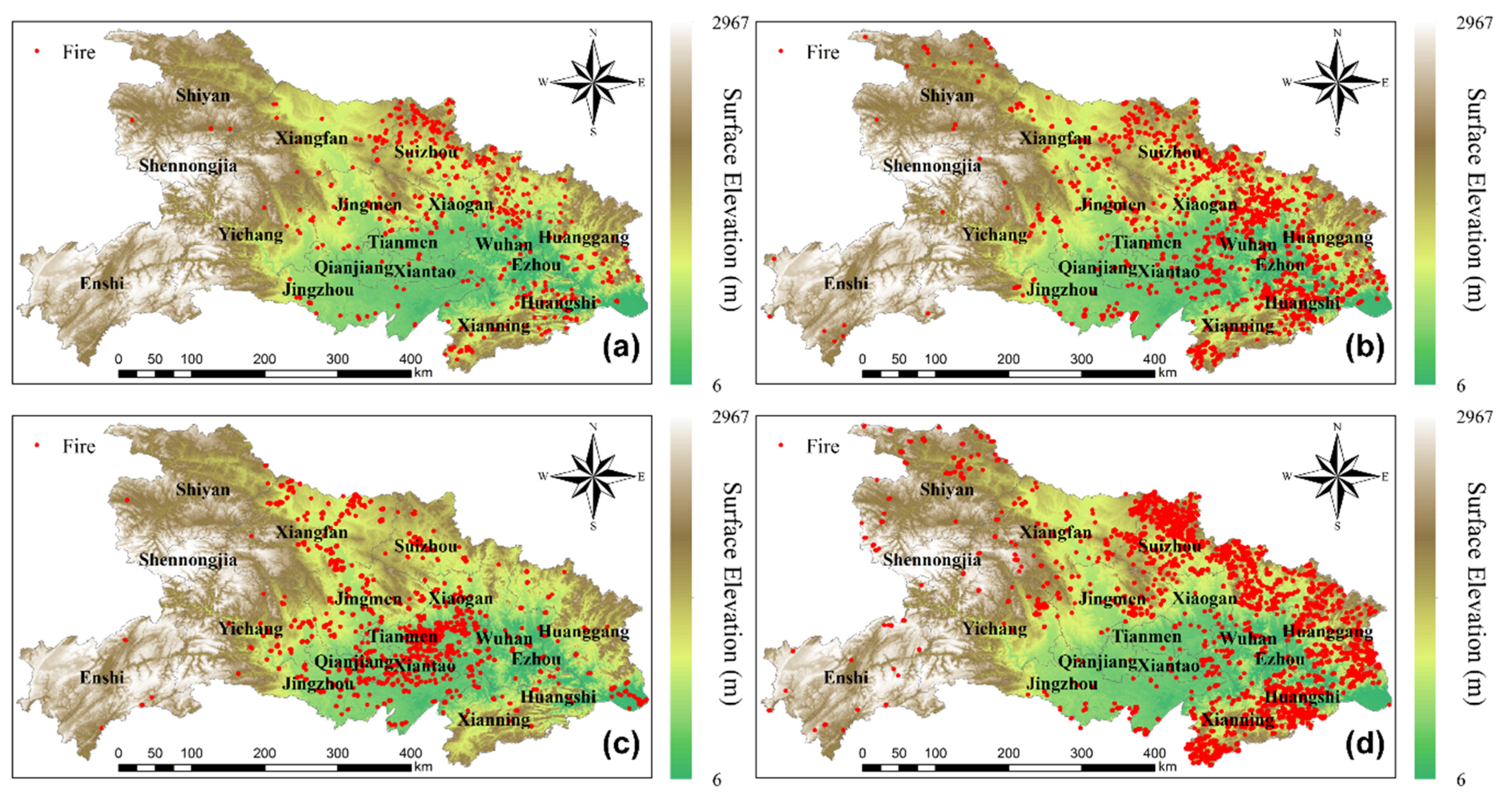
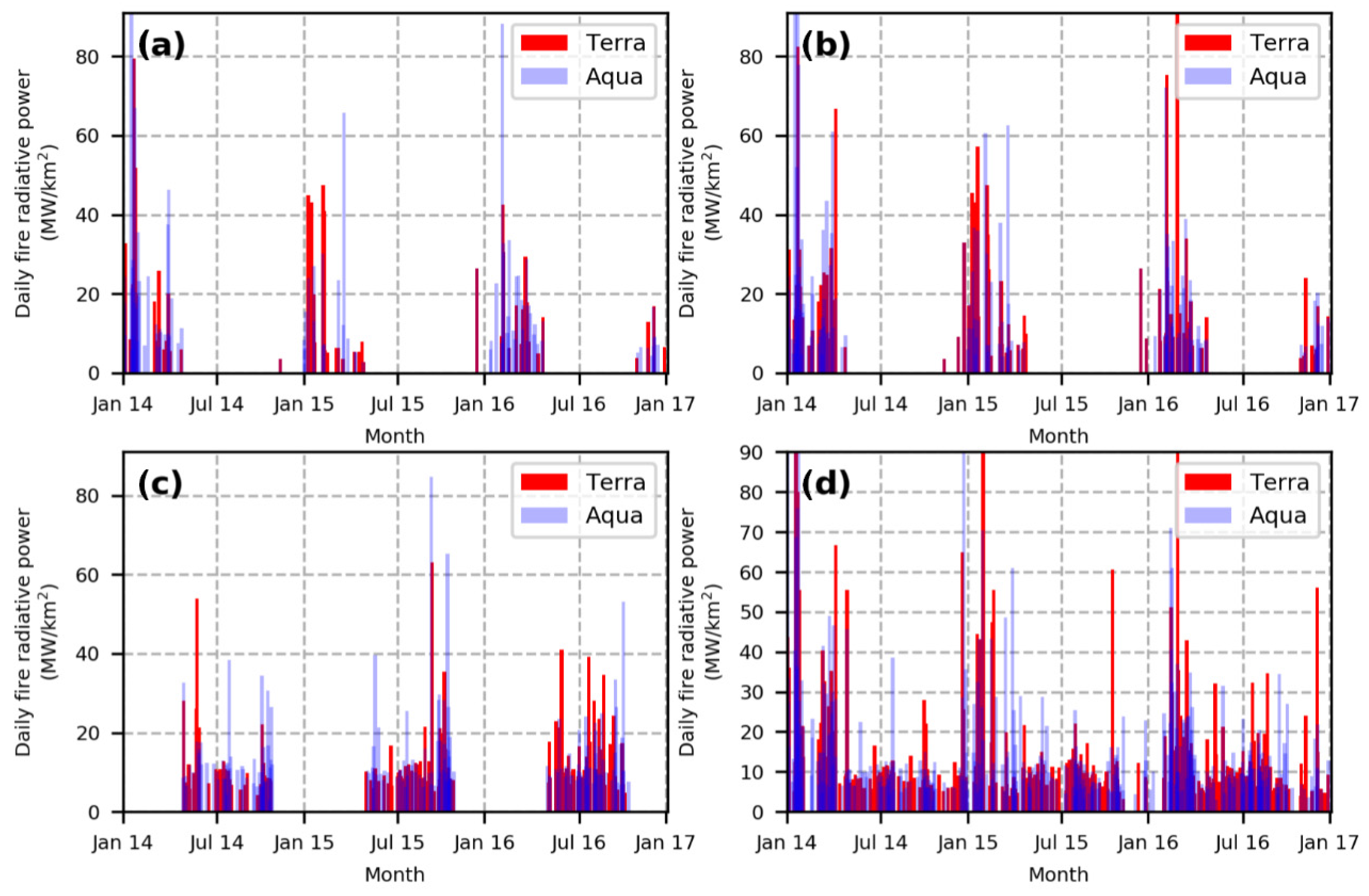
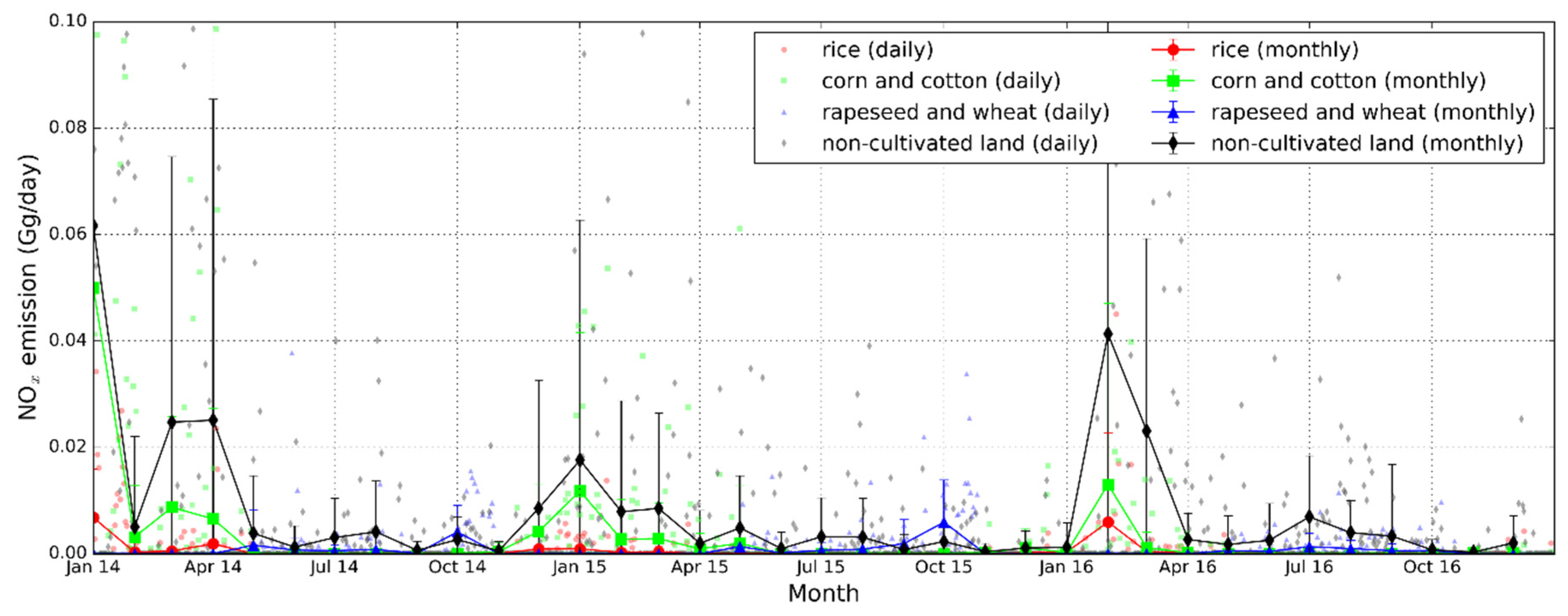
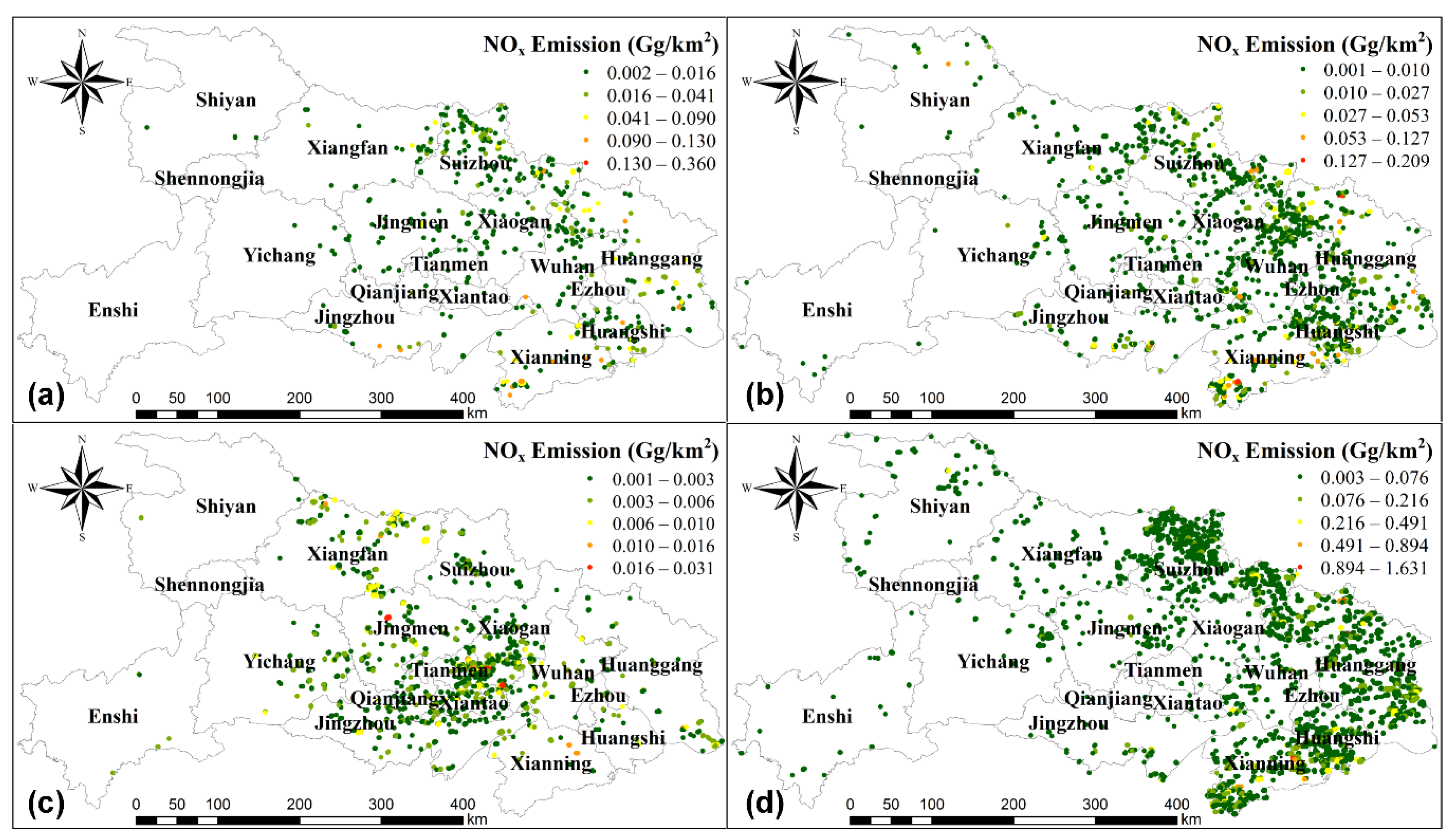
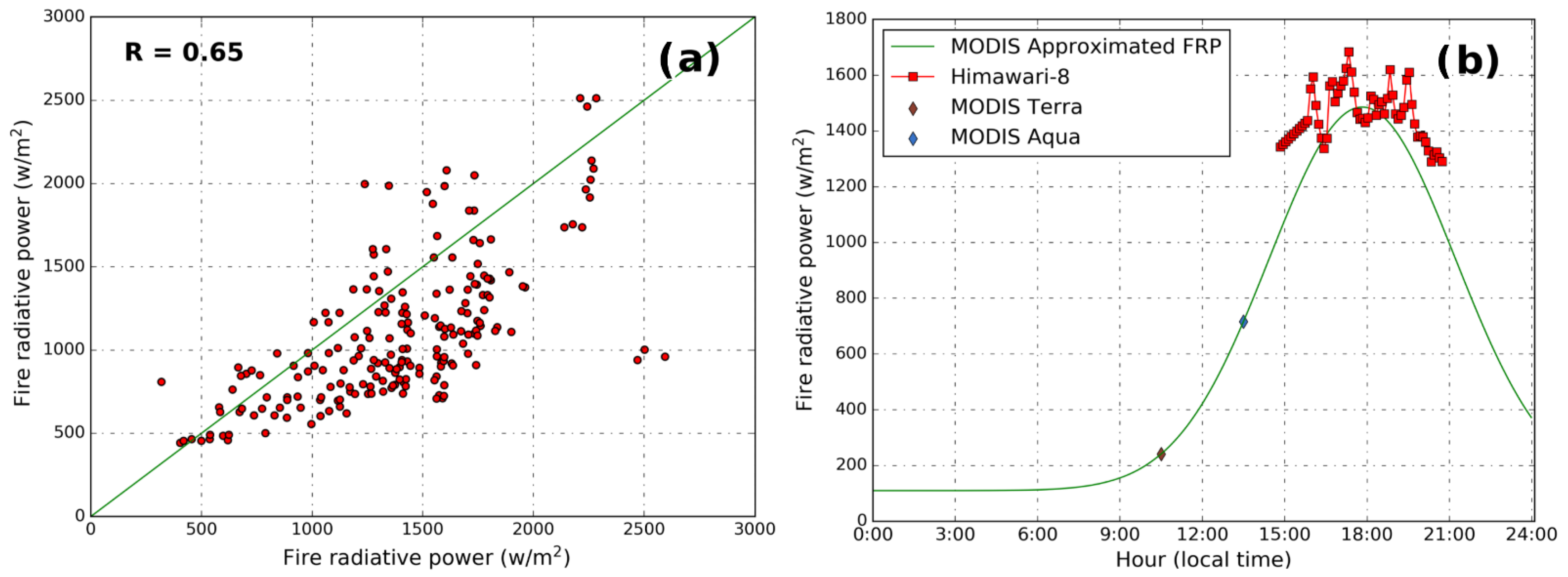
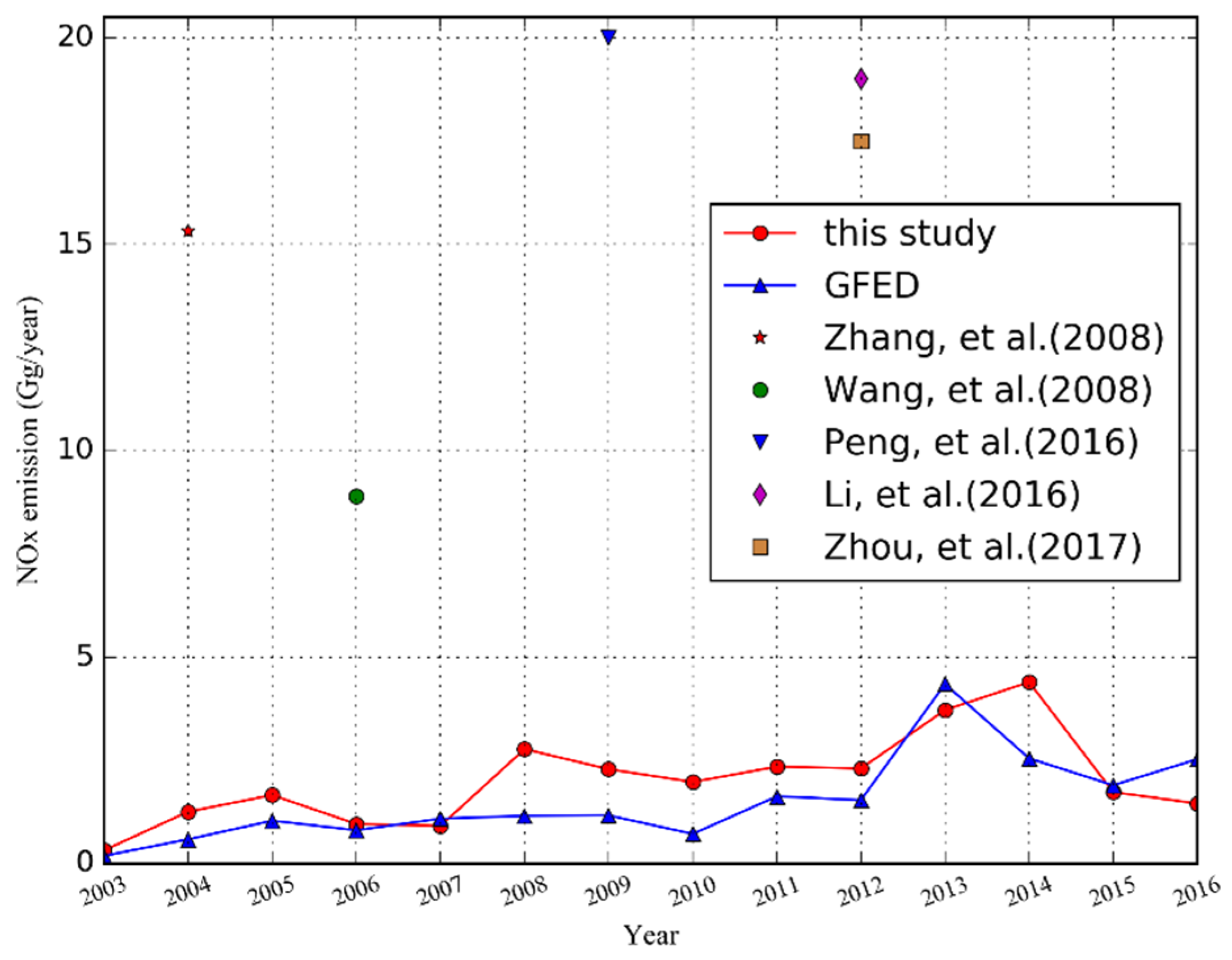

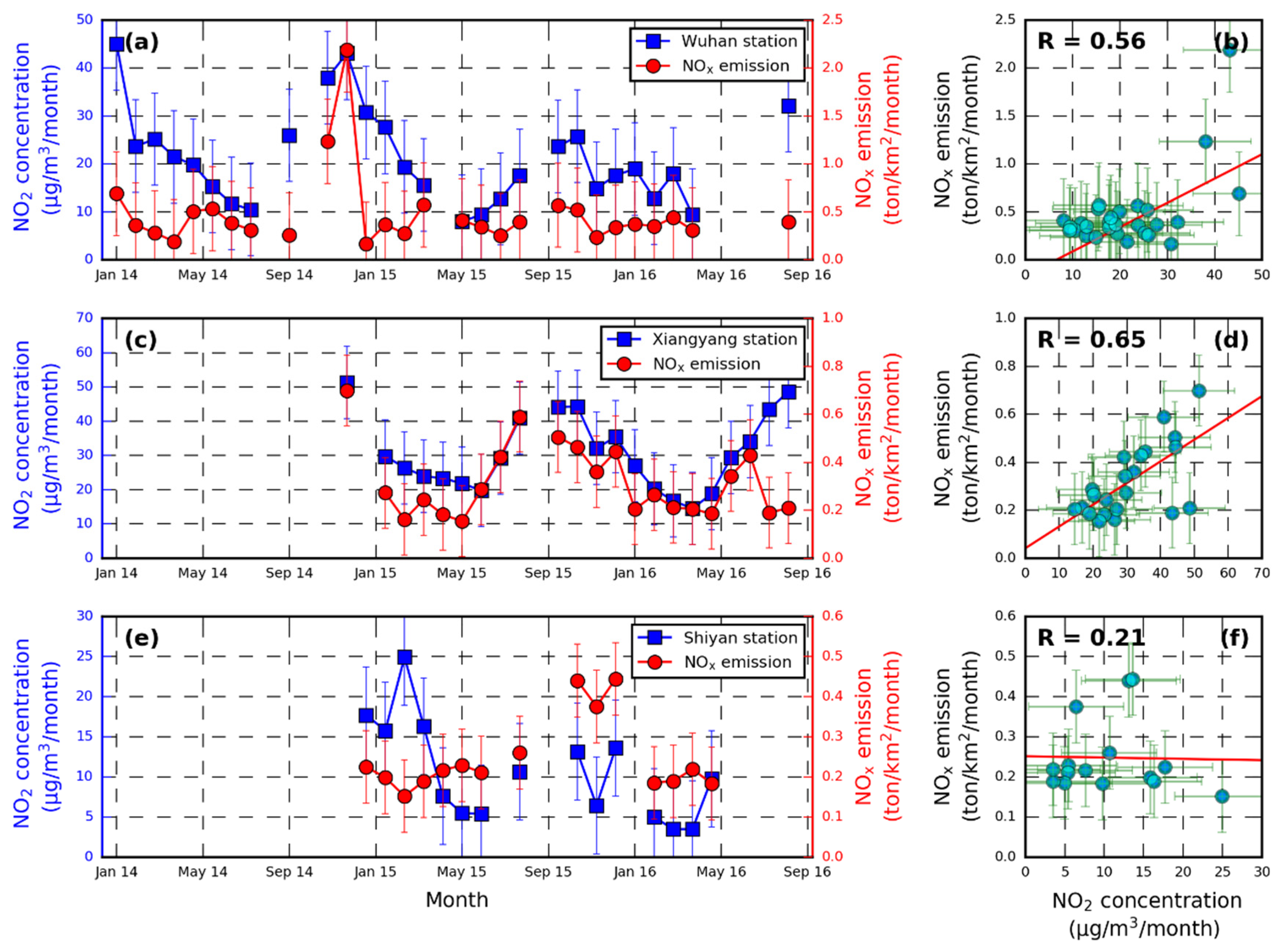
| Rice | Wheat | Corn | Cotton | Rapeseed | Reference |
|---|---|---|---|---|---|
| 3.431.08 | 2.281.00 | 3.600.85 | 2.490.23 | Cao et al. [49] | |
| 3.31.7 | 4.31.8 | Li et al. [50] | |||
| 1.14 | 1.27 | Zhang et al. [51] | |||
| 3.834.30 | 3.063.00 | Zhang et al. [52] | |||
| 1.42 | 3.31 | 4.3 | 2.68 | Guan et al. [47] | |
| 1.420.46 | 1.19 ± 0.02 | 1.12 ± 0.15 | Tang et al. [45] | ||
| 2.65 | 1.34 | 2.98 | 2.68 | He et al. [46] | |
| 1.81 ± 0.09 | 1.12 ± 0.19 | 1.28 ± 0.04 | Zhang et al. [8] | ||
| 3.1 | 3.3 | 4.3 | 3.37 | 3.37 | Li et al. [53] |
| 1.81 | 3.3 | 3.36 | 2.98 | 1.12 | Wu et al. [44] |
| 1.42 | 1.19 | 3.36 | 2.98 | 1.12 | this study |
Publisher’s Note: MDPI stays neutral with regard to jurisdictional claims in published maps and institutional affiliations. |
© 2021 by the authors. Licensee MDPI, Basel, Switzerland. This article is an open access article distributed under the terms and conditions of the Creative Commons Attribution (CC BY) license (http://creativecommons.org/licenses/by/4.0/).
Share and Cite
Shen, Y.; Jiang, C.; Chan, K.L.; Hu, C.; Yao, L. Estimation of Field-Level NOx Emissions from Crop Residue Burning Using Remote Sensing Data: A Case Study in Hubei, China. Remote Sens. 2021, 13, 404. https://doi.org/10.3390/rs13030404
Shen Y, Jiang C, Chan KL, Hu C, Yao L. Estimation of Field-Level NOx Emissions from Crop Residue Burning Using Remote Sensing Data: A Case Study in Hubei, China. Remote Sensing. 2021; 13(3):404. https://doi.org/10.3390/rs13030404
Chicago/Turabian StyleShen, Yonglin, Changmin Jiang, Ka Lok Chan, Chuli Hu, and Ling Yao. 2021. "Estimation of Field-Level NOx Emissions from Crop Residue Burning Using Remote Sensing Data: A Case Study in Hubei, China" Remote Sensing 13, no. 3: 404. https://doi.org/10.3390/rs13030404
APA StyleShen, Y., Jiang, C., Chan, K. L., Hu, C., & Yao, L. (2021). Estimation of Field-Level NOx Emissions from Crop Residue Burning Using Remote Sensing Data: A Case Study in Hubei, China. Remote Sensing, 13(3), 404. https://doi.org/10.3390/rs13030404





